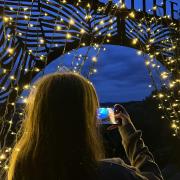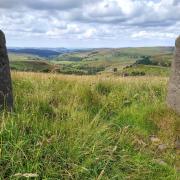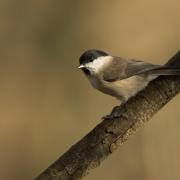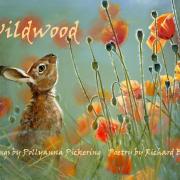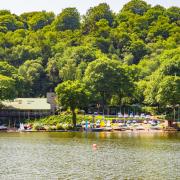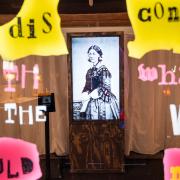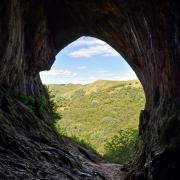As autumn morphs into winter, bands of marauding thrushes, like the Vikings a thousand years ago, battle against the gales of the North Sea and arrive in Britain.
And, like the Vikings, they are here to plunder our rich resources.
When we lament the state of our weather (outside, of course, the justifiable concerns such as the recent floods) we often don't realise just what it is like a few hundred miles away in northern Europe.
Whilst it tends to be mild and mainly wet here, in Scandinavia and the Baltic states the winter is drier and also far colder.
The soil is often frozen and hidden beneath a blanket of snow. This means that the abundant larder of worms and insects that many birds fed avidly on during the spring and summer is now unavailable, and the situation is exacerbated by the large increase in bird numbers after a successful breeding season.
As Scandinavia's autumn progresses, this larder rapidly empties and the thrushes then search for berries such as those of the rowan.

However, if the weather deteriorates, these don't last long. It is now that the birds flock together, brave the harsh elements and cross the inhospitable North Sea.
When these bands of thrushes arrive they tend to herald their approach, particularly the large and noisy fieldfares.
They continuously chatter to each other. A loud and persistent chack-chack, which grabs your attention before you look up and spot the birds silhouetted against the grey sky.
The flying flocks are easy to recognise. The birds' size is a clue, smaller than a pigeon or rook, larger than a twittering goldfinch.
Once they hit the west coast they fan out across England and make their way east and south where they encounter our resident thrushes.

This is a nightmare for our local blackbirds, song thrushes and mistle thrushes because they have prepared for winter by making sure they know where all the berry-rich rowans and hawthorns are.
Most of our resident thrushes don't migrate. They don't really need to because our mild climate provides enough food locally to allow them to survive nearly all that our winter can throw at them.
If there isn't a frost the soil and woodland leaf litter remain rich with worms and insects. However, if there is a cold snap, the birds will switch to berries in urban gardens and the rowans and hawthorns which bejewel the frozen countryside with their scarlet and crimson berries.
The first signs of the arrival of the ‘invaders’ is often in our gardens, where there is a noticeable increase in the number of blackbirds.
The residents have lost their placid ways of the previous few weeks and are constantly squabbling as they try to drive away the hungry, new arrivals.

One inaccurate fact which I grew up with was that the foreign males have dark beaks, not the bright yellow of our resident male blackbird.
They do have dark beaks, but this is simply because they are young birds. As spring approaches, they will develop the yellow beak of an adult before they head off back to their homeland.
In general, the chunky fieldfares and slimmer redwings tend to head for more rural areas and don't seek out our gardens, but this changes if the winter weather takes a significant downturn.
Once they can't find any worms in the frozen soil they switch to berries, mainly hawthorn and, as the flocks increase with new arrivals, they can literally strip the countryside of its fruit.
It is now that they head to more urban areas, which are often still rich with fruit-laden rowans, and gardens containing cotoneaster, ivy, holly and viburnum.

The poor resident blackbirds, song and mistle thrushes are overrun. Mistle thrushes are our scarcest and largest resident thrush and they will try to defend their trees from any invaders.
However, the equally large foreign fieldfares and smaller redwings have a simple game plan. They swoop down in groups of ten to 20 and overwhelm the resident mistle thrushes who try to drive them away.
If the winter is a harsh one, it can be an amazing ornithological feast to witness. Last winter, you may recall that we had a period of at least a week where temperatures were constantly below freezing.
There are four rowan trees near to where I live and, at the beginning of the cold snap, they were laden with berries.
Three days later flocks of birds, which included blackbirds, fieldfares, redwings and starlings, were flying in at five-minute intervals.

A single resident mistle thrush tried to defend his territory but he was unsuccessful, and, on the ground below, five song thrushes mopped up any fallen berries.
Two days later all four trees had been stripped bare and the flocks had moved on. A rather sad mistle thrush and two blackbirds remained, their winter larder completely empty. However, it was an unforgettable experience and I was able to photograph the whole event.
In the past, orchards were commonplace and fallen apples were a fantastic food source for the Scandinavian invaders.
However, there are very few orchards left. Many gardens contain fruit trees and these can supply much needed sustenance, but this does require a slight change in our behaviour.
Instead of picking all the fruit, why not leave half to fall naturally or be eaten directly from the tree. Many people feed garden birds with seeds and peanuts, but you can supplement these with bruised apples and pears which can be thrown out onto the lawn.
I have found that if you ask your local greengrocer or supermarket they will often give you bruised or damaged fruit in return for a contribution to the charity box.
So, if we get another hard winter this year, take a moment to look and listen for the flocks of invaders moving across our land and, if you see a berry-laden rowan, wait until the birds discover it and you will be in for an amazing spectacle.




